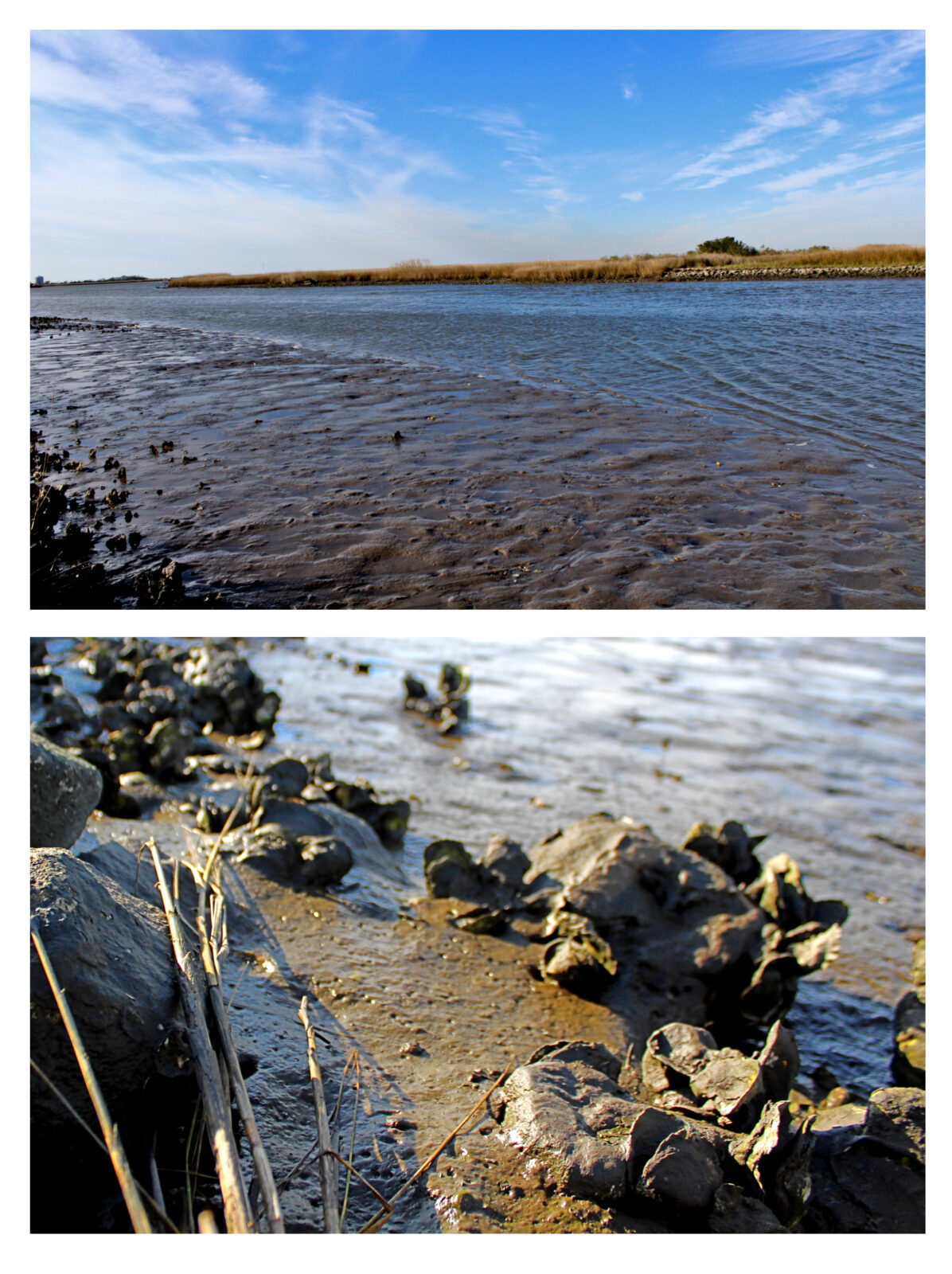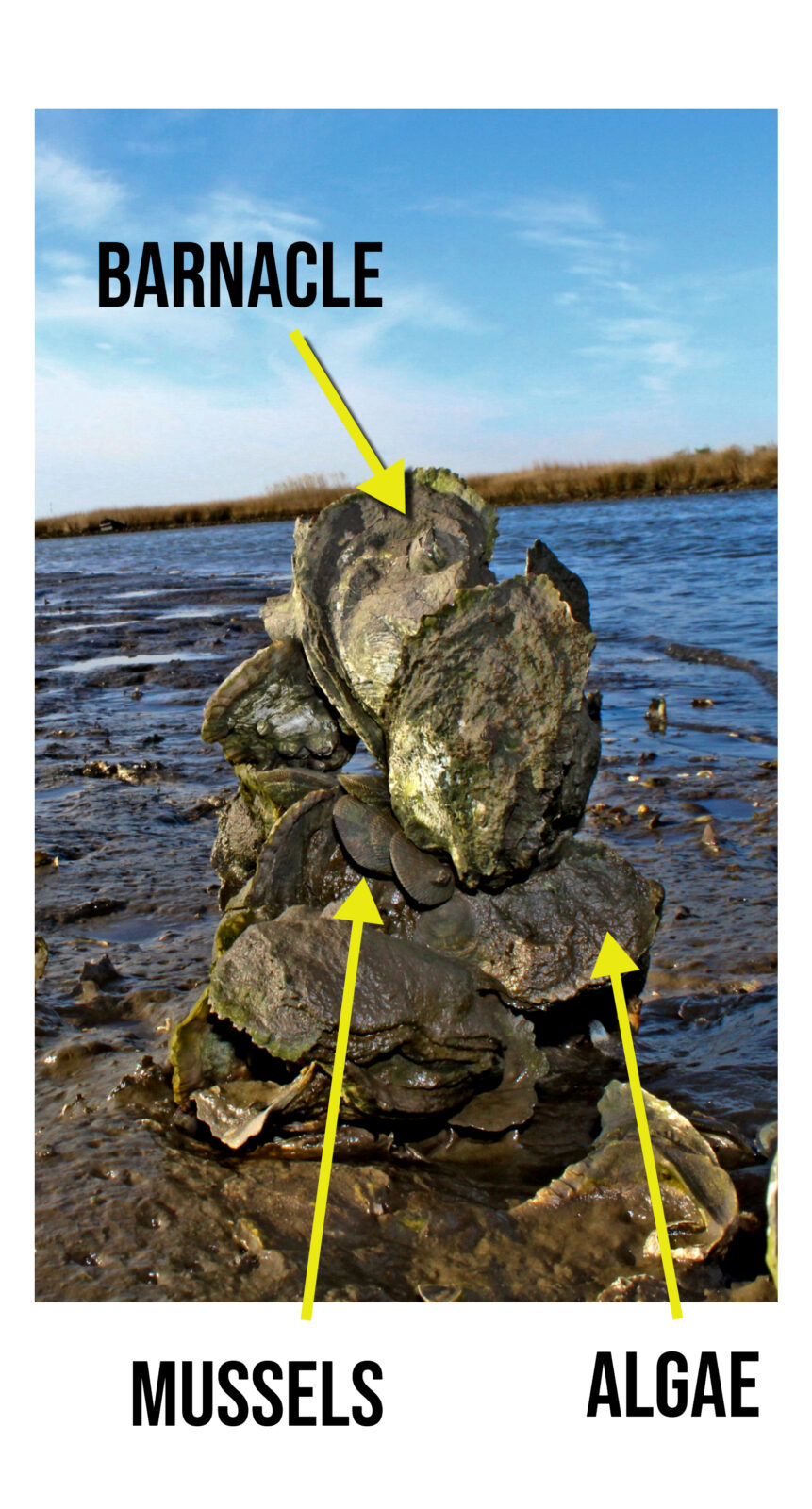
Mudflats are intertidal (submerged at high tide and not at low tide) habitats that have soft muddy bottoms and no plants in the areas with weaker currents. The soft muddy bottoms are made up of fine particles that tend to build up in these areas and are constantly reshaped into smaller or larger areas. Oyster reefs are located in salty or brackish water areas in estuaries that look rock-like and are formed when clusters of oysters grow together on any hard surface. We often see them on old shells, pilings of docks, and rocks. Each of these habitats is unique and provides habitat for many other species.
The Physical Eniverment of Mudflats and Oyster Reefs
Both mudflats and oyster reefs are coastal environments found in tidal areas. That means both of these environments are exposed to air at times and submerged at other times. During the times they are exposed to the atmosphere they are also exposed to air, rain, wave action, and constant changes in temperature and the lack of water. When they are covered in water these areas are a bit more protected by the water but still have to deal with currents, and changes in water conditions (temperature, pH, amount of salt, and amount of oxygen). The key difference between the two habitats is that mudflats are soft muddy bottom habitats while oyster reefs are hard surface habitats with many nooks and crannies for things to hide in. Each is unique and valuable but in the past have often been not thought of as areas that needed much attention and care. Mudflats because they were muddy and a bit “gross” since they often smell like rotten eggs. And oyster reefs because they look like rocks and that makes them seem more like features that would always be there. But remember, oyster reefs are made up of living animals that are also vital in protecting shorelines from erosion.
Did you know: Mudflat hiking is becoming a common and popular pastime for humans? What are your thoughts on this new eco-adventure activity?
Biology of Mudflats and Oyster Reefs
Mudflats are seen as a very important part of the SUPER TEAM (mudflats, salt marshes, and oyster reefs) of sustaining fish and bird populations. The life found on mudflats is made up of a lot of invertebrate species like burrowing clams, crabs, small crustaceans, and worms. They are also important feeding grounds for shore and wading birds, fish, crabs, and rays. They can do this because as the sediment layers are brought in nutrients get trapped in the layers of mud. These nutrients are energy-rich and can support a large and complex food web. Animals that make mudflats homes need to be able to cope with what happens at low tide. Mostly, the animals that live in the mud will dig burrows to prevent them from drying out. This is particularly true for the worms and other soft-bodied animals, but some crabs will do the same thing. The bivalves (two shells) like oysters will seal themselves inside the 2 parts of their shell, like a book being closed, until the water comes back in.
One of the most recognized habitats in the salt marsh-mudflat ecosystem is the oyster reef. Oysters start life as free-floating microscopic swimming animals. But as they reach adulthood they must attach to a hard surface and transform into a small oyster, called spat. They have to do this to mature into adults. Most often, the shells of other oysters, dead or alive, turn out to be the perfect solid surface for attachment. This is how oyster reefs are created. Reefs that have been around for a while have generation upon generation of oysters on top of one another. Other hard surfaces work too. No matter what, once a reef takes shape it becomes a “living habitat” by providing shelter for other species. Oysters are filter feeders, and adult oysters are capable of filtering up to four gallons of water an hour. This makes oysters extremely important in improving water quality by filtering things from the water, including bacteria, algae, detritus (basically dead matter), and suspended sediments. For all of the above reasons, oysters are often referred to as a keystone species, or a species that shapes an ecosystem and on which several other species in the ecosystem depend. Many of the species that spend time around oyster reefs are valuable to our fishing community and industry. The food web surrounding these habitats is complex, just like mudflats. If you think about it makes sense. Many of the species settle on the oysters including mussels, barnacles, anemones, and even sponges. All of which are eaten by some other species. Those nooks and crannies provide great places for small animals to find shelter from predators.

Can you use the photo to the left as inspiration for drawing an oyster reef food web? What would eat the oyster, mussels, and barnacles? How is the algae making energy to survive?

